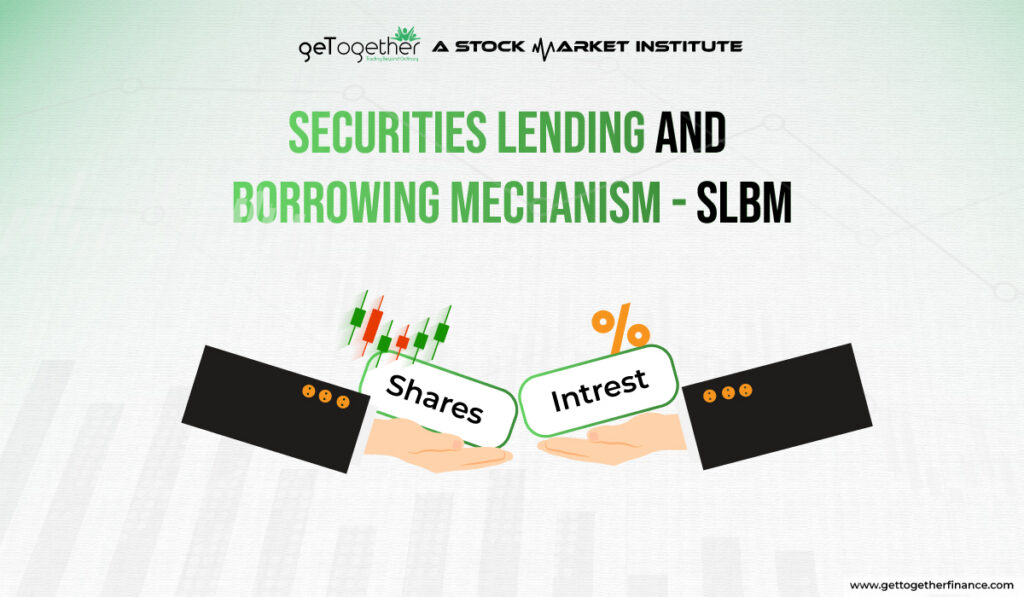Securities Lending and Borrowing Mechanism – SLBM
- May 8, 2024
- 3556 Views
- by Manaswi Agarwal


Securities Lending and Borrowing Mechanism (SLBM) is a system or method through which traders can either borrow shares that are not owned by them or they can lend the stock that they own. The process of lending or borrowing is operated on a rate of interest and a fixed tenure. The transactions are carried out under the operation of National Stock Exchange where agreements are signed by the parties to maintain the security of lenders. Through SLBM, investors can gain additional income and leverage their portfolio through dividend earnings.
What is SLBM?

Securities lending and Borrowing is a legally approved method through which lending and borrowing of securities takes place on the National Stock Exchange (NSE). The rules and regulations of this method were originally formed by SEBI in May 1997. All market participants like retail investors and long term investors excluding foreign investors are permitted to participate in the lending and borrowing mechanism. This can only be done through an Authorized Intermediary. Brokerage charges are borne by the parties involved in the process. The two parties involved in the SLB mechanism are lenders and borrowers.
Lender
A long term investor who does not have an active portfolio can lend the shares by charging a fee which depends on demand and time value. A lender can lend the stock to have a supplement income where the lending amount is not restricted. Basically lenders include insurance companies, banks, mutual funds, retail investors, etc.
Borrower
Borrower is an institution or an investor who borrows from a lender for the purpose of short selling. This is done by paying an amount of fee or interest and with the borrowed amount an investor can engage into hedging and arbitrage opportunities.
How Does SLBM Work?

An investor interested in lending the share must instruct the broker to place orders. The participants in SLBM that are lenders and borrowers must get themselves registered with a stock exchange. The exchange is responsible to match the borrower’s request for securities from the lending pool. The loan is initiated after the matching process is done.
For instance; if an investor wants to lend 100 shares of ABC stock and another participant is willing to buy the shares at Rs3 for a month. So, the return for the lender would be Rs 36 per share for a year without the risks associated. The process is carried through the stock exchange where the agreements are signed under SLBM rights with the obligation forms.
Benefits of SLBM for Lenders

Lenders can better utilize their investments by lending shares that are kept idle in their portfolio. Let’s know the potential benefits for lenders through SLB transactions.
Incremental Income on Investments
Through SLB transactions, investors can generate extra income by lending idle shares. Lenders are eligible to receive fees which generate additional revenue streams for an investor contributing to overall portfolio returns.
Versatile Portfolio
Lenders, as a participant, have the opportunity to optimize their investment portfolio and create versatility for better returns. The investment risk is spread across a broader range of activities thereby; investors gain exposure to different asset classes.
Eliminating Risks
SLBM allows investors to eliminate maximum risk and hedge positions more effectively. The process is risk free for lenders because of the collateral provided by the borrower as a protection in this transaction.
Enhanced Market Liquidity
Through SLBM transactions, lenders lend the money and increase the market liquidity. An increase in market liquidity is beneficial for lenders because of reduced trading costs and smooth buying and selling of securities takes place.
Benefits of SLBM for Borrowers

The process of SLB fulfills the short term needs of securities for the borrowers. The securities are used to perform short selling and hedging to gain profits in future. Let’s understand how it can be beneficial for borrowers:
Access to Securities
Investors who need securities for a short term have access to the securities through SLBM transactions. Investors can execute their trading strategies efficiently through short term opportunities provided to nourish their portfolio through hedging or other activities.
Hedging
As the securities are provided for a short term, borrowers can make use of SLBM for hedging in their investment portfolio to prevent potential losses. Borrowers can reduce their overall risk in the portfolio by balancing the losses of one and gaining profits in the other one.
Cost Effective
Borrowers can find SLB transactions to be cost saving because borrowing for temporary needs instead of making a purchase prevents transaction costs. There are capital requirements and transaction costs which are borne by the owner of the security, a borrower doesn’t have to bear these costs and hence results in saving costs.
Short Selling
Short Selling is the main purpose of borrowing securities wherein the borrowers sell these securities in the market as they expect the prices will decrease in future and they’ll buy them at lower prices. This allows the investors to gain profits as the price decreases in future.
Also Read: Short Covering Long Unwinding
Limitations of Securities Lending and Borrowing Mechanism

Apart from certain benefits, there are several limitations of lending and borrowing securities. Some of the main risks associated with securities lending and borrowing mechanism includes:
Regulatory Obligations
The participants are subject to several regulatory obligations while getting into the contract. Several regulatory compliances like capital adequacy, legal restrictions might affect the efficiency of SLB contracts and result in increased compliance costs.
Liquidity Risks
During the times of market volatility, the transaction in SLBM market may dry up leading to increased difficulties in buying and selling of the securities. Due to this, market participants might have to face operational challenges which can hamper their trading strategies.
The Bottom Line
Long term investors make additional profits by lending their securities to the borrowers. This transaction is very secure as it is performed under the rules and regulations of a registered stock exchange. However, there are several costs that are associated with SLBM transactions which must be deeply understood by both the parties to carry the process smoothly and effectively. Investors can get updated about the interest rates as per the stock from the website of National Stock Exchange.
FAQ’S
Q1. What is SLBM and its full form?
Securities Lending Borrowing Mechanism (SLBM) is a method which allows investors to lend or borrow the securities for which an amount of interest is to be paid by the borrower.
Q2. Who is a lender in SLB transactions?
A lender in SLB is the one who lends the shares to the borrower for a certain amount of interest which is an additional income for the investor.
Q3. Who is a borrower in the SLB transaction?
A borrower in the SLB is the one who borrows shares from the lender and pays an amount of interest in return. A borrower can use these shares for hedging or short selling purposes.
Q4. What are the charges of SLBM transactions?
Generally, the brokerage charges for SLB transactions are approximately 15% + GST which are levied on the lending fee. A participant must check associated costs with the broker before getting into the process.
Q5. How does SLB transaction work?
SLBM transactions are operated under the rules and regulations of the stock exchange where the parties sign an agreement and fulfill obligation requirements.



 Instagram
Instagram 
